Simmered in a delicate tomato-based sauce, Japanese Stuffed Cabbage Rolls is a beloved Western-style dish prepared by Japanese home cooks since 1895! Make this comforting recipe for your family or a dinner party—it’s a savory and satisfying meal for a crowd.
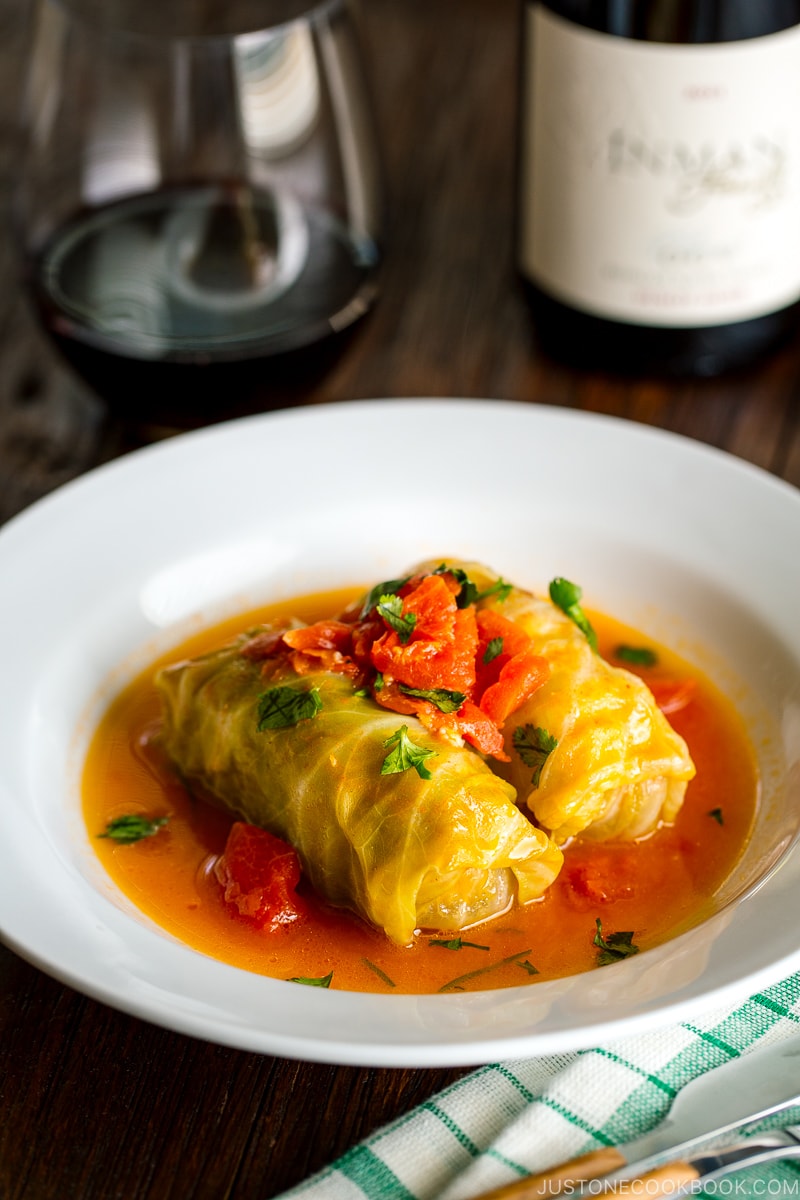
Do you love food that comes with a rich history, especially one that carries a tapestry of cultures? This brings us to today’s recipe—Stuffed Cabbage Rolls, a popular yoshoku (western-style Japanese) dish enjoyed, especially during fall and wintertime.
I have personally found it fascinating and enduring how a dish of tender cabbage wrapped around a variety of fillings becomes a common staple shared by so many cultures.
Now let us take a look at its origin and how it became a staple in Japan before I show you how to make the Japanese version of stuffed cabbage rolls at home!
Table of contents
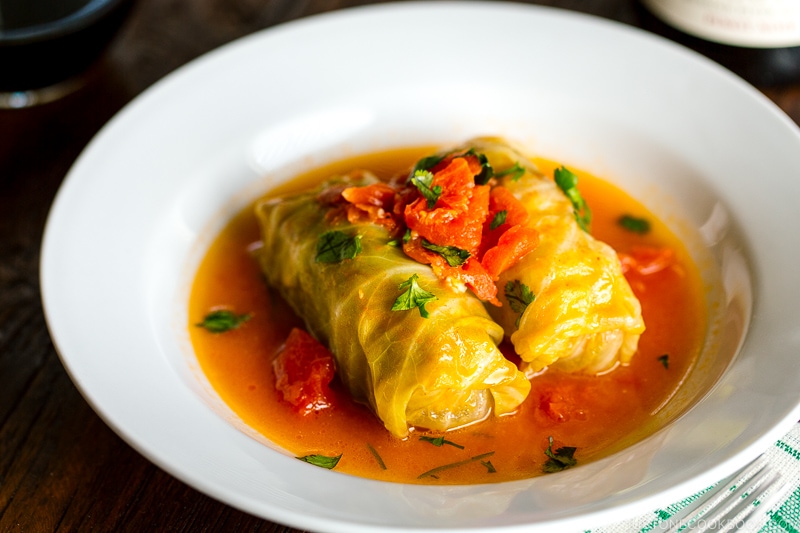
What Are Japanese Stuffed Cabbage Rolls?
Stuffed Cabbage Rolls are a dish consisting of blanched cabbage leaves wrapped around a variety of fillings. They are common in the cuisines of the Balkans and Central/Northern/Eastern Europe. The dish was first introduced to Japan in the women’s magazine Jokan (女鑑) in 1895 and quickly became a beloved home-cooking dish. I believe one reason for its popularity is its use of cabbage when it’s in abundance, making it an economical yet nutritious cold-weather vegetable.
Alongside Hamburger Steak (Hambagu), Spaghetti Napolitan, and Omurice, Stuffed Cabbage Rolls represent a creative demonstration of how the Japanese adopt and adapt foreign influences into their unique cuisine.
How is the Japanese Version Different?
Unlike the classic Polish style or other European stuffed cabbage rolls , the Japanese version doesn’t include rice (although there are various versions within Japan). Typically, in Japan, we sauté onions and combine them with ground meat, usually a mix of beef and pork. The stuffing is then wrapped with a cooked cabbage leaf and simmered in some kind of soup base—this can be tomato-based, like in today’s recipe, a simple consomé, or a wafu (Japanese-style) soup base with dashi broth. Sometimes, we also wrap a slice of bacon around the cabbage roll.
The Japanese almost always make this dish on the stovetop, mainly because that’s the most common way of cooking meals in Japan (not everyone has an oven like the American kitchen). However, you can easily transform the dish into a casserole by baking it in the oven.
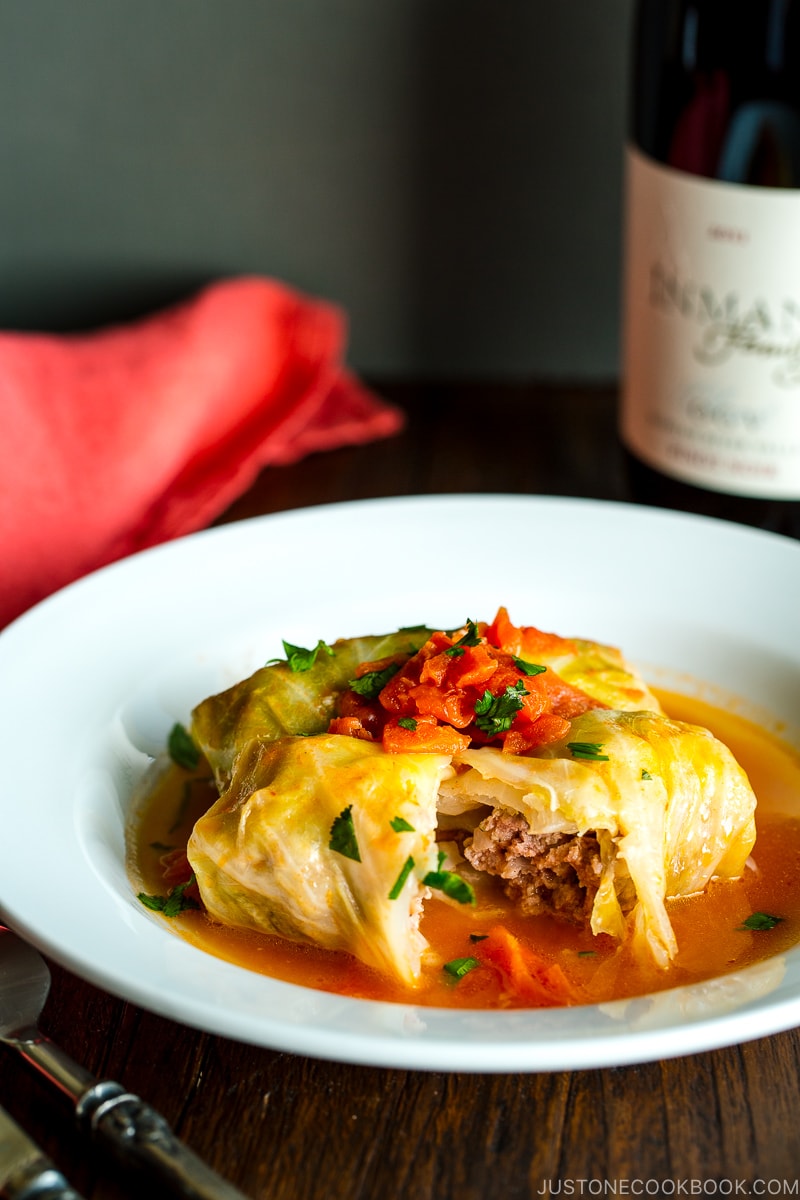
How to Make Japanese Stuffed Cabbage Rolls
The Ingredients You’ll Need
- Sweet onion
- Green cabbage
- Ground meat – I recommend a mix of ground beef and ground pork.
- All-purpose flour
- Olive oil, salt, and pepper
- Stuffing seasoning: Egg, panko breadcrumbs, nutmeg, salt, and pepper
- Tomato-based sauce: Bay leaves, garlic, diced tomatoes, white wine, salt and pepper, chicken/vegetable stock, unsalted butter
Cooking Tips
- Use a mixture of ground beef and pork. While many recipes might call for just ground beef, in Japan, we prefer using this combination because the addition of ground pork results in a more tender texture and a robust flavor.
- Let the meat mixture rest in the fridge for at least 15-30 minutes. Cooling the mixture helps solidify the fat, keeps the meat juicy, and prevents it from drying out. This process seals in and enhances the umami flavor.
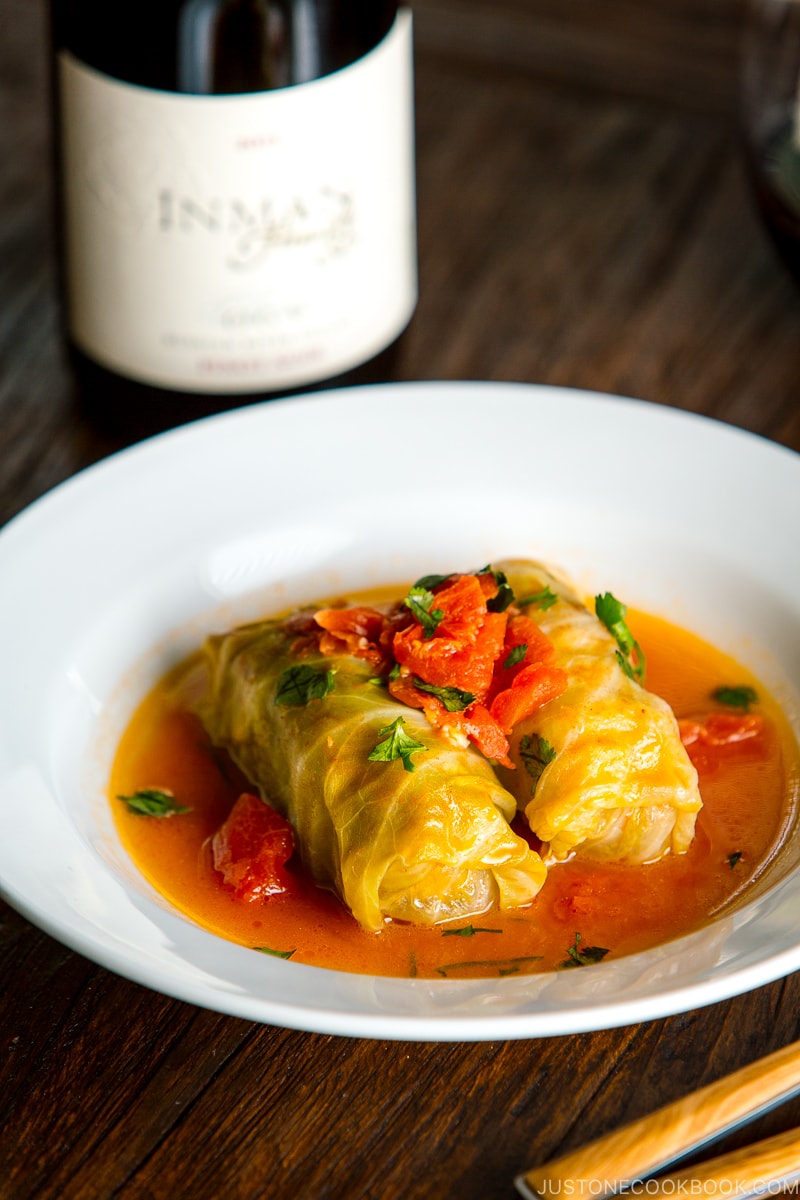
Japanese Stuffed Cabbage Rolls – Amazing Comfort Food
Savory meat fillings rolled up in tender sweet cabbage, each bite is just bursting with flavor when bathed in the tangy tomato sauce. It’s definitely a comfort food that I look forward to eating when I come home from the cold weather outside.
The great part is that you can make stuffed cabbage rolls ahead of time and they still taste great, so it can be a nice dish to bring to a potluck or dinner party.
I hope you enjoy this Japanese Stuffed Cabbage Rolls recipe.
More Western-Style Japanese Recipes You Might Enjoy
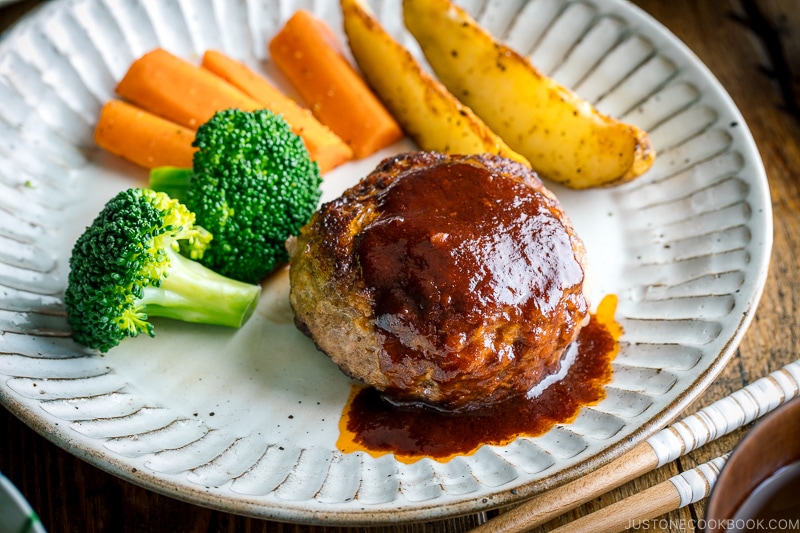
- Japanese hamburger Steak (Hambagu)
- Tonkatsu (Japanese Pork Cutlet)
- Instant Pot Cream Stew
- Hayashi Rice
- Seafood Doria (Rice Gratin)
Wish to learn more about Japanese cooking? Sign up for our free newsletter to receive cooking tips & recipe updates! And stay in touch with me on Facebook, Pinterest, YouTube, and Instagram.
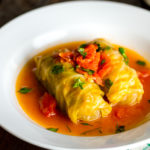
Japanese Stuffed Cabbage Rolls
Video
Ingredients
- ½ onion
- 2 Tbsp extra virgin olive oil (divided)
- 1 head green cabbage
- 1 tsp Diamond Crystal kosher salt (for boiling the cabbage)
- 1 Tbsp all-purpose flour (plain flour)
For the Meat Stuffing
- 1 lb ground meat (I prefer a mix 75% beef and 25% pork; ¾ lb, 340 g beef and (¼ lb, 113 g pork)
- 1 large egg (50 g each w/o shell)
- ⅓ cup panko (Japanese breadcrumbs)
- 2 Tbsp milk
- ½ tsp nutmeg
- 1 tsp Diamond Crystal kosher salt
- ⅛ tsp freshly ground black pepper
For the Sauce
- 2 bay leaves
- 1 clove garlic (minced)
- 1 can diced tomatoes (14.5 oz, 411 g)
- 1 Tbsp white wine
- ½ tsp Diamond Crystal kosher salt
- ⅛ tsp freshly ground black pepper
- 1 cup chicken or vegetable stock
- ½ Tbsp unsalted butter
For the Garnish
- parsley (chopped)
Instructions
- Gather all the ingredients. I also use 12 toothpicks (optional) to secure the seams of the cabbage rolls.
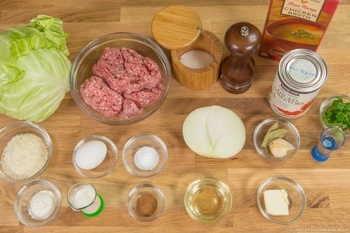
- Mince ½ onion. Lay the onion half on the cutting board, flat side down. With the knife tip pointing toward the root end, make ⅛-inch vertical slices, again keeping the root intact. Next, with the knife edge toward the root end, make ⅛-inch horizontal slices to within ½ inch of the root end.

- Finally, make perpendicular cuts down through the vertical slices you made. If you need to chop the onions finer, run your knife through them using a rocking motion. Hold down the tip of the knife; otherwise, the onions will go flying around the room.

- In a frying pan, heat 1 Tbsp extra virgin olive oil on medium heat. Sauté the onion until tender, about 4 to 6 minutes. Set aside.

To Prepare the Cabbage
- Start boiling 2 QT (2L) water or enough needed to submerge the head of cabbage. When the water is boiling, add 1 tsp Diamond Crystal kosher salt. Carefully remove the center core only of 1 head green cabbage with the tip of a knife.

- Completely submerge the whole head of cabbage in the boiling water. Cook it until the leaves are pliable and start to peel off, about 5 minutes. (If doubling the recipe, cook one head of cabbage at a time.) Using kitchen tongs or a fork, peel off the loosened outer cabbage leaves and remove them from the pot.

- Soak the leaves in iced water to stop the cooking. Remove the excess water from them with a salad spinner or pat dry with a paper towel. Use a knife to trim the tough, thick center vein at the base of each leaf (cut them off in an upside-down V shape). Alternatively, you can shave down this thick part. For a beginner cook, I recommend simply cutting it off.

- Chop the thick veins into small pieces, which you will add to the stuffing.

To Make the Meat Stuffing
- To a large bowl, add 1 lb ground meat, the sautéed onion, and the chopped cabbage vein pieces. Mix with your clean hands or a rubber spatula.

- Add 1 large egg (50 g each w/o shell), ⅓ cup panko (Japanese breadcrumbs), 2 Tbsp milk, ½ tsp nutmeg, 1 tsp Diamond Crystal kosher salt, and ⅛ tsp freshly ground black pepper.

- Mix well until the mixture is sticky and thoroughly combined. Cover with plastic wrap and keep in the refrigerator for 15–30 minutes. While chilling the meat mixture is optional, I recommend this step because it solidifies the fat, keeps the meat juicy, prevents it from drying out, and enhances and traps the umami flavor.

To Stuff the Cabbage Leaves
- Divide the mixture into 12 equal parts (I roughly divided into 8 first and adjusted the amounts later).

- Put 1 Tbsp all-purpose flour (plain flour) into a fine-mesh sieve for dusting. Working with one cabbage leaf at a time, overlap the bottom of the leaf where you cut out the thick vein. Lightly dust some flour onto the leaf. The flour helps the stuffing stick to the cabbage and acts as a binding agent. Add one portion of stuffing to the bottom center of the leaf close to the stem end.

- Starting with the stem end, tightly roll up the stuffing in the cabbage, tucking in the sides of the leaf as you roll.

- Use one hand to pull the edge of the leaf and roll the fillings tightly toward the tip of the leaf.

- Secure the seam with a toothpick so the roll doesn’t fall apart while cooking (optional). Repeat with the remaining leaves and stuffing.

- What if the cabbage leaf is broken? You can still use it. Use a smaller cabbage leaf to “patch up“ and roll the filling the same way.

To Cook the Cabbage Rolls
- In a large pot (I use a 6¾ QT oval Dutch oven), heat the remaining 1 Tbsp olive oil on medium heat. Cook 2 bay leaves and 1 clove garlic (minced) until fragrant. Then, stir in 1 can diced tomatoes.

- Reduce the heat to medium low. Add 1 Tbsp white wine, ½ tsp Diamond Crystal kosher salt, and ⅛ tsp freshly ground black pepper, and bring it to a simmer.

- Gently add the cabbage rolls to the pot side by side in rows, seam side down. If there are any open spaces in the pot, stuff with the leftover boiled cabbage so the rolls don‘t move around while cooking. Add 1 cup chicken or vegetable stock.

- Place an otoshibuta (drop lid) on top of the rolls. If you don’t have a drop lid or your pot is not round, you can make a drop lid with aluminum foil (see my tutorial). Cover with the pot lid and cook on medium heat. When it boils, lower the heat to medium low and simmer for 30 minutes. When the cabbage rolls are done cooking, add ½ Tbsp unsalted butter to give it a little shine and more flavor.

To Serve
- When you are ready to serve, carefully pick up the stuffed cabbage rolls with kitchen tongs and place them on a serving dish. Remove the toothpick and pour the sauce on top. Garnish with chopped parsley and serve.
To Store
- Transfer the leftover Stuffed Cabbage Rolls to an airtight container and let them cool completely. You can store them in the refrigerator for up to 3 days and the freezer for up to a month.
Nutrition
Editor’s Note: This post was originally published on July 9, 2015.
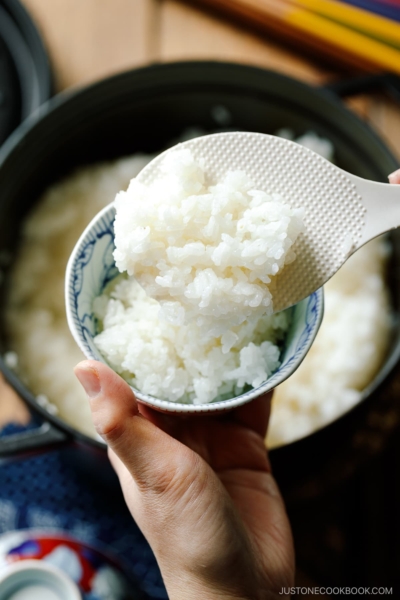
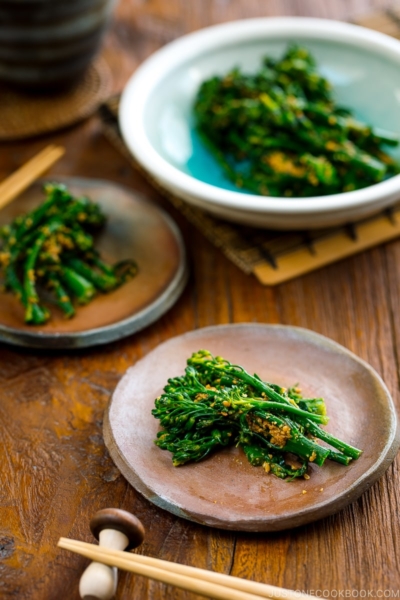
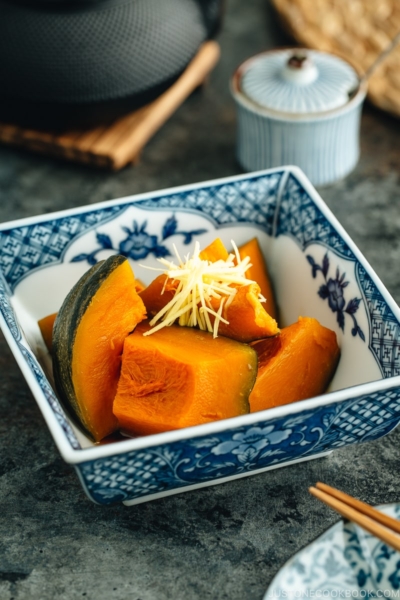
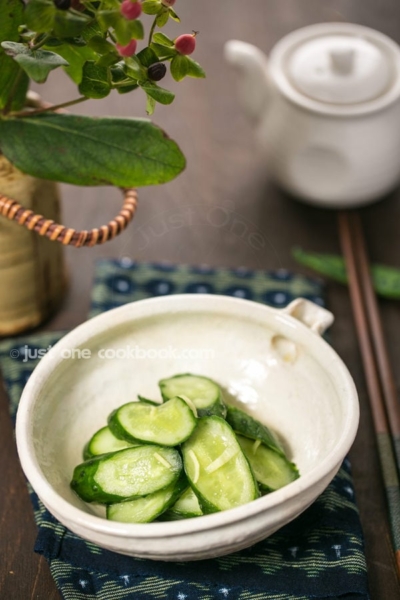





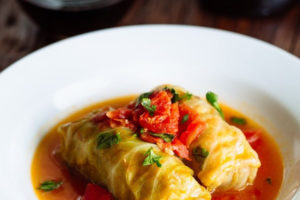
The best cabbage rolls I’ve ever had. My family loves these rolls. Making them tonight! Great recipe
Hello Erica! Thank you very much for trying Nami’s recipe and for your kind feedback!
We hope your family continues to enjoy the recipe! 🤗
can I use my Ginpo donabe for the Stuffed cabbage Rolls recipe? Is the Ginpo clay pot oven safe? I have seasoned it like you suggested Thanx for your help
Hey, Robyn. Thank you for using Nami’s recipe.
You can use your Ginpo donabe for this recipe, although the smell might stay in the donabe for a while. Regarding oven safety, according to their website, you can use it in the oven, but without the lid. Hopefully, this helps!
I am planning to make this and i was wondering if i could add carrots (sautéed) in the meat stuffing to make it more flavourful and have more different textures as well as nutrition.
Is that possible?
Hi Lexi, Thank you for trying Nami’s recipe.
Yes, you can sauté the carrots together with the onion. The carrots will add sweetness to the dish, so feel free to adjust the amount of seasoning to your preferences.
We hope everyone enjoys the dish. Happy cooking!
I had a head of cabbage I had to use up and decided to make these rolls. I was never a fan of cabbage, but after making this, I am so in love with cabbage, as long as they’re used in this recipe. This came out so, so good! The mixed meat, the soup, and the cabbage that basically melts as you eat it. It does take a bit to make, but worth it. I was able to stretch and make 13 rolls. I was afraid that the meat wouldn’t cook thoroughly, so I made them slightly smaller, but after, I realized I could just cook it longer. I made this gluten free by using GF panko by Kikkoman and GF flour, and ate it with rice. Thank you so much for posting this recipe!
Hi Amy! We are happy to hear you like cabbage now!☺️
Thank you for attempting Nami’s recipe and sharing your thoughts and experiences with us.
Happy Cooking!
These are so good! It’s now my 5th time making them. The perfect Japanese twist on something that seems Hungarian 🙂 Delish
Hello, Adam! Wow! We are happy to hear you enjoyed this dish very much. Thank you very much for trying Nami’s recipe and rating it 5 stars!🤩
Happy Cooking!
I haven’t made these for years, but now I’ll have to soon. I can’t have gluten so I substitute rinsed quinoa for the panko (bread crumbs, cracker meal, etc.) I have never sprinkled my cabbage leaves with flour. I will try it with some gf flour. I assume it’s to help the filling adhere to the leaves? Thank you for another great recipe!
Hi Janet, Thank you so much for reading Nami’s post and trying her recipe!
Yes. As Nami mentioned in the recipe card, the flour helps the stuffing stick to the cabbage and acts as a binding agent.
We hope you enjoy the dish!
I love this Japanese version. But what is the role of the breadcrumb? I’ve never thought of using breadcrumbs in filling.
Hi Trang, Thank you so much for trying Nami’s recipe!
The breadcrumbs (Panko) help keep the flavor and moisture of the stuffing, so we highly recommend it.
We hope this helps!